Subscribe to our ▶️ YouTube channel 🔴 for the latest videos, updates, and tips.
Subtraction of Decimal Fractions
In subtraction of decimal fractions we will discuss here how to subtract one decimal from the other decimal.
Subtraction of decimal numbers are similar to subtraction of whole numbers. We convert them to like decimals and place the numbers vertically one below the other in such a way that the decimal point lies exactly on the vertical line. Subtract as usual as we learnt in the case of whole numbers.
The rules of subtracting decimal numbers are:
(i) Write the digits of the given numbers one below the other such that the decimal points are in the same vertical line.
(ii) Subtract as we subtract whole numbers.
Let us consider some of the examples on subtraction of decimal numbers.
1. Subtract 8.93 from 13.94.
Here, all the decimal fractions are in like decimals.
13.94 - 8.93
Write 8.93 below 13.94 and the decimal points are placed in the same vertical line and then subtract in the same way as we do in case of whole numbers.
Atlast place the decimal point in the result in line with the other decimal points.
2. Subtract 191.765 from 843.92.
First change the decimal fraction to like decimals, 191.765 has three decimal places so convert 843.92 into 843.920.
843.920 - 191.765
Write 191.765 below 843.920 and the decimal points are placed in the same vertical line and then subtract in the same way as we do in case of whole numbers.
Atlast, place the decimal point in the result in line with the other decimal points.
3. Find 492 kg 500 g - 283 kg 650 g.
Here, all the decimal fractions are in like decimals.
492.500 - 283.650
Now write 283.650 below 492.500 and the decimal points are placed in the same vertical line and then subtract in the same way as we do in case of whole numbers.
Atlast, place the decimal point in the result in line with the other decimal points.
4. Find 10.0008 - 0.007
First change the decimal fraction to like decimals, 10.0008 has four decimal places so convert 0.007 into 0.0070.
10.0008 - 0.0070
Now subtract as usual,
5. Subtract 17.053 from 81.519
Here, all the decimal fractions are in like decimals.
81.519 - 17.053
Now subtract as usual,
6. Subtract $64.75 from $74.50
Here, all the decimal fractions are in like decimals.
74.50 – 64.75
Now subtract as usual,
7. Subtract 81 kg 753 g from 189 kg 843 g
189.843 – 81.753
Now arrange the decimal numbers in vertical line and subtract as usual,
8. Subtract 93.05 from 98.1
Change the decimal fractions to like decimal fractions.
98.10 - 93.05
Now arrange the decimal numbers in vertical line and subtract as usual.
9. Subtract 14.83 from 70
Change the decimal fractions to like decimal fractions.
70.00 – 14.83
Now subtract as usual.
10. Subtract 79.79 from 89
Change the decimal fractions to like decimal fractions.
89.00 – 79.79
Now subtract as usual.
Atlast, place the decimal point in the result in line with the other decimal points.
11. Subtract 6.156 from 8.8
Solution:
Converting the given decimals into like decimals, we get 6.156 and 8.800
Hence, 8.800 - 6.156 = 2.644.
Working Rules for Subtraction of Decimals:
For subtraction of decimals, we have to follow these steps:
Step I: Change the given decimal into like decimals.
Step II: Write the numbers in columns, so that decimal points should come in one column.
Step III: Now, subtract the decimals just as we subtract the whole numbers.
Step IV: Put the decimal in the difference directly under the decimal points of all the decimals.
Solved Example on Subtraction of Decimals:
1. Subtract 36.314 from 49.69.
Solution:
|
Converting into like decimals. 49.69 → 49.690 36.314 → 36.314 |
49 . 690 - 36 . 314 13 . 376 |
Therefore, 49.69 - 36.314 = 13.376
● Decimal.
- Decimal Place Value Chart.
- Expanded form of Decimal Fractions.
- Like Decimal Fractions.
- Unlike Decimal Fraction.
- Equivalent Decimal Fractions.
- Changing Unlike to Like Decimal Fractions.
- Ordering Decimals
- Comparison of Decimal Fractions.
- Conversion of a Decimal Fraction into a Fractional Number.
- Conversion of Fractions to Decimals Numbers.
- Addition of Decimal Fractions.
- Problems on Addition of Decimal Fractions
- Subtraction of Decimal Fractions.
- Problems on Subtraction of Decimal Fractions
- Multiplication of a Decimal Numbers.
- Multiplication of a Decimal by a Decimal.
- Properties of Multiplication of Decimal Numbers.
- Problems on Multiplication of Decimal Fractions
- Division of a Decimal by a Whole Number.
- Division of Decimal Fractions
- Division of Decimal Fractions by Multiples.
- Division of a Decimal by a Decimal.
- Division of a whole number by a Decimal.
- Properties of Division of Decimal Numbers
- Problems on Division of Decimal Fractions
- Conversion of fraction to Decimal Fraction.
- Simplification in Decimals.
- Word Problems on Decimal.
5th Grade Numbers Page
5th Grade Math Problems
From Subtraction of Decimal Fractions to HOME PAGE
Didn't find what you were looking for? Or want to know more information about Math Only Math. Use this Google Search to find what you need.


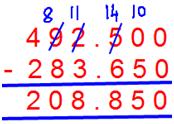
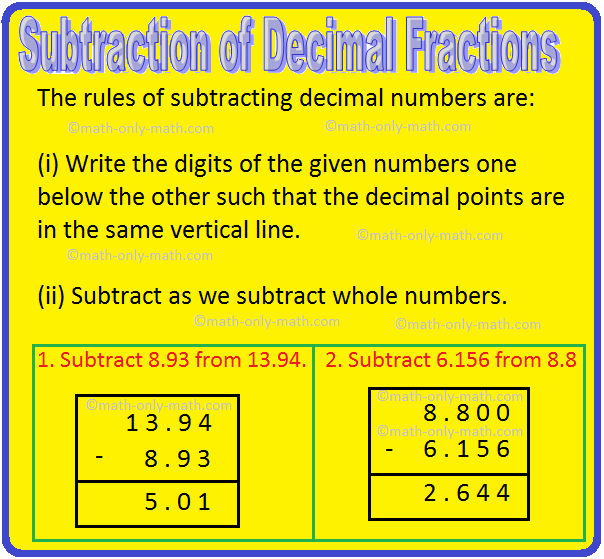

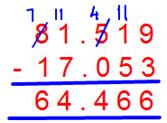
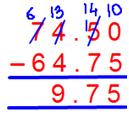
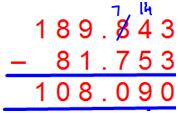



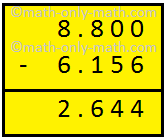


New! Comments
Have your say about what you just read! Leave me a comment in the box below. Ask a Question or Answer a Question.